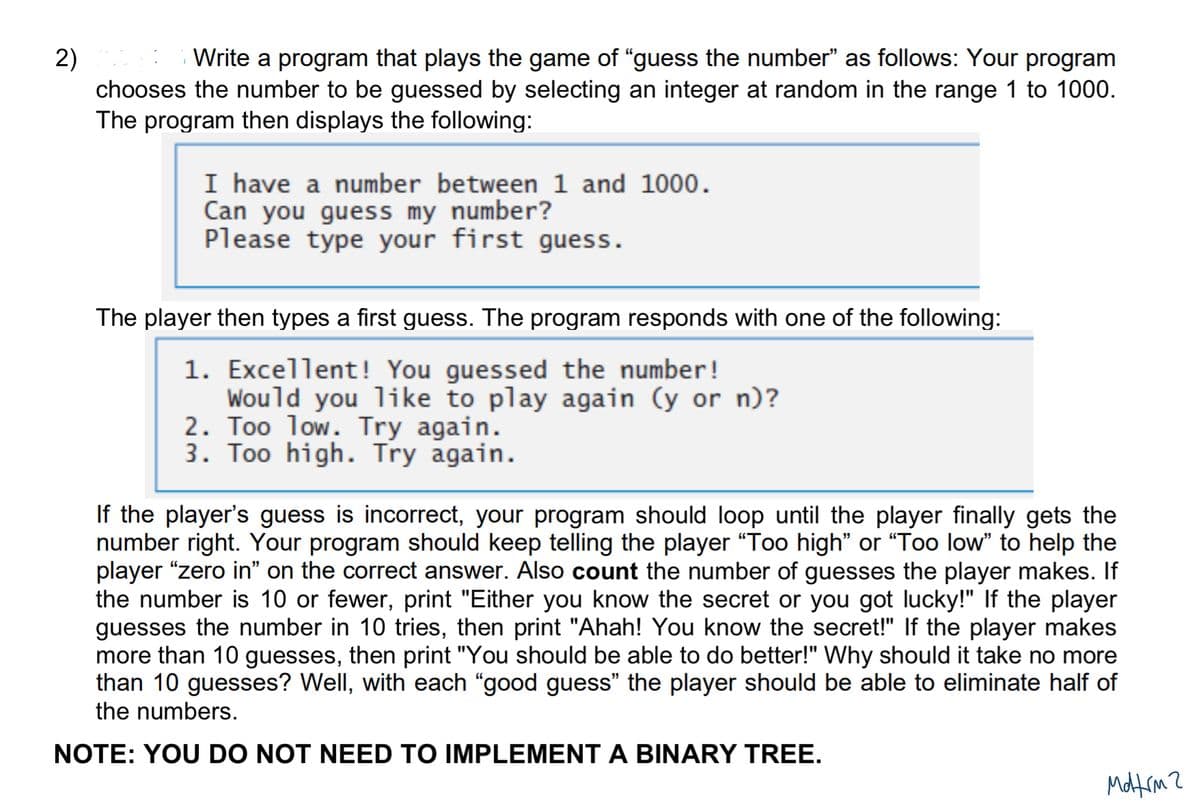2) Write a program that plays the game of "guess the number" as follows: Your program chooses the number to be guessed by selecting an integer at random in the range 1 to 1000. The program then displays the following: I have a number between 1 and 1000. Can you guess my number? Please type your first guess. The player then types a first guess. The program responds with one of the following: 1. Excellent! You guessed the number! Would you like to play again (y or n)? 2. Too low. Try again. 3. Too high. Try again. If the player's guess is incorrect, your program should loop until the player finally gets the
2) Write a program that plays the game of "guess the number" as follows: Your program chooses the number to be guessed by selecting an integer at random in the range 1 to 1000. The program then displays the following: I have a number between 1 and 1000. Can you guess my number? Please type your first guess. The player then types a first guess. The program responds with one of the following: 1. Excellent! You guessed the number! Would you like to play again (y or n)? 2. Too low. Try again. 3. Too high. Try again. If the player's guess is incorrect, your program should loop until the player finally gets the
C++ for Engineers and Scientists
4th Edition
ISBN:9781133187844
Author:Bronson, Gary J.
Publisher:Bronson, Gary J.
Chapter5: Repetition Statements
Section5.5: A Closer Look: Loop Programming Techniques
Problem 14E
Related questions
Question
In C++

Transcribed Image Text:2)
Write a program that plays the game of "guess the number" as follows: Your program
chooses the number to be guessed by selecting an integer at random in the range 1 to 1000.
The program then displays the following:
I have a number between 1 and 1000.
Can you guess my number?
Please type your first guess.
The player then types a first guess. The program responds with one of the following:
1. Excellent! You guessed the number!
Would you like to play again (y or n)?
2. Too low. Try again.
3. Too high. Try again.
If the player's guess is incorrect, your program should loop until the player finally gets the
number right. Your program should keep telling the player "Too high” or “Too low" to help the
player "zero in" on the correct answer. Also count the number of guesses the player makes. If
the number is 10 or fewer, print "Either you know the secret or you got lucky!" If the player
guesses the number in 10 tries, then print "Ahah! You know the secret!" If the player makes
more than 10 guesses, then print "You should be able to do better!" Why should it take no more
than 10 guesses? Well, with each "good guess" the player should be able to eliminate half of
the numbers.
NOTE: YOU DO NOT NEED TO IMPLEMENT A BINARY TREE.
монсти
Expert Solution
This question has been solved!
Explore an expertly crafted, step-by-step solution for a thorough understanding of key concepts.
This is a popular solution!
Trending now
This is a popular solution!
Step by step
Solved in 3 steps with 1 images

Knowledge Booster
Learn more about
Need a deep-dive on the concept behind this application? Look no further. Learn more about this topic, computer-science and related others by exploring similar questions and additional content below.Recommended textbooks for you

C++ for Engineers and Scientists
Computer Science
ISBN:
9781133187844
Author:
Bronson, Gary J.
Publisher:
Course Technology Ptr

C++ Programming: From Problem Analysis to Program…
Computer Science
ISBN:
9781337102087
Author:
D. S. Malik
Publisher:
Cengage Learning

Microsoft Visual C#
Computer Science
ISBN:
9781337102100
Author:
Joyce, Farrell.
Publisher:
Cengage Learning,

C++ for Engineers and Scientists
Computer Science
ISBN:
9781133187844
Author:
Bronson, Gary J.
Publisher:
Course Technology Ptr

C++ Programming: From Problem Analysis to Program…
Computer Science
ISBN:
9781337102087
Author:
D. S. Malik
Publisher:
Cengage Learning

Microsoft Visual C#
Computer Science
ISBN:
9781337102100
Author:
Joyce, Farrell.
Publisher:
Cengage Learning,